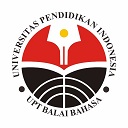The Use of Firaa in “Marugoto: Japanese Language and Culture” Textbooks for Beginner (A1) and Elementary (A2) Levels
Abstract
Keywords
Full Text:
PDFReferences
Daikuhara, H. (2010). Nihonggo Kyouiku ni Okeru Firaa no Shidou no Tame no Kisoteki Kenkyuu: Fira no Teigi to Koko no Keishiki no Tsukaiwake ni Tsuite [Basic research for teaching fillers in Japanese: Definition of fillers and proper use of its’ forms]. Unpublished Thesis. Kobe: Kobe University.
Fujita, Y. (2001). Functions of Discourse Markers in Japanese. Texas Papers in Foreign Language Education, 6(1), 147-162.
Higgins, C., & Ikeda, M. (2021). The materialization of language in tourism networks. Applied Linguistics Review, 12(1), 123-152.
Januarika, V. (2018). Analisis Penggunaan Firaa (フィラー) pada Penutur Asing Dalam Acara Wawancara Orang Asing [The Use of Firaa (フィラー) used by Foreign Speakers in Foreigner Interviews]. Unpublished Graduation Thesis. Jakarta: Universitas Negeri Jakarta.
Kim, O. (2007). Pause Fillers and Gender in Japanese and Korean: A Comparative Sociolinguistics Study. Unpublished Thesis. The University of Hawai’i.
Lukamto, Y. R. (2012). Nihon ni Okeru Danwa Hyōshiki ni Tsuite: Nihongo Kyouiku no Kanten kara [Discourse Markers in Japanese: From the perspective of Japanese language education]. Unpublished Thesis. Osaka: OUKA.
Momose, M. (2022). Filler words in Japanese textbooks and Japanese classes. Journal of Japanese Linguistics, 38(1), 71-96.
Nagai, A. (2017). The Fillers in Dialogues Produced by Learners of Japanese. Nihongo kyōiku hōhō kenkyūkai-shi, 24, 10-11.
Nakajima, E. (2009). Fillers in Natural Discourse: Analysis of Natural Conversational Data. Asia Japan Journal, 4(4).
Ohta, K., Kitaoka, N., & Nakagawa, S. (2014). Modeling Filled Pause and Silences for Responses of a Spoken Dialogue System. International Journal of Computers, 8, 141.
Park, S. T. (2019). Nihongo to kankokugo no fira- no kinou ni kansuru kenkyuu—sesshoku bamen ni chakumokushite [Research on the function of fillers in Japanese and Korean: Focusing on conversation]. Japanese literature, 82, 123-139.
Schiffrin, D. (1987). Discourse Markers. Cambridge: Cambridge University Press.
Sugiyono. (2013). Metode Penelitian Pendidikan Pendekatan Kuantitatif, Kualitatif, dan R&D [Educational Research Quantitative, Qualitative, and R&D Approaches]. Bandung: Alfabeta.
The Japan Foundation-Language Institute. (2017). MarugotoElementary1ActivitiesMp3.https://www.marugoto.org/en/download/elementary1_a/(accessed on 15 January, 2020)
The Japan Foundation-Language Institute. (2017). MarugotoElementary1CompetencesMp3.https://www.marugoto.org/en/download/elementary1_c/ (accessed on 15 January, 2020)
The Japan Foundation-Language Institute. (2017). MarugotoElementary2ActivitiesMp3.https://www.marugoto.org/en/download/elementary2_a/(accessed on 15 January, 2020)
The Japan Foundation-Language Institute. (2017). MarugotoElementary2CompetencesMp3.https://www.marugoto.org/en/download/elementary2_c/ (accessed on 15 January, 2020)
The Japan Foundation-Language Institute. (2017). MarugotoStarterActivitiesMp3.https://www.marugoto.org/en/download/starter_a/ (accessed on 15 January, 2020)
The Japan Foundation-Language Institute. (2017). MarugotoStarterCompetencesMp3.https://www.marugoto.org/en/download/starter_c/ (accessed on 15 January, 2020)
Watanabe, M. (2005). Filled Pauses as Cues to Complexity of Following Phrases. Interspeech, 2, 37-40.
Watanabe, M., Hirose, K., Den, Y., & Minematsu, N. (2005). Filled pauses as cues to the complexity of following phrases. In Ninth European Conference on Speech Communication and Technology.
Katsura, T. (2015). Kinou ni motoduku nihingo fira- no shiyou jittai: chuugokujin nihongo gakushuusha to nihongo bogowasha tono taishou ni chakumoku shite [Function-based Japanese Filler Usage: Focusing on the contrast between Chinese learners of Japanese and native speakers of Japanese]. Graduate school of integrated science for global society, 2, 35-44. Kyushu university.
Yamane, C. (2002). Nihongo no Danwa ni Okeru Firaa. Unpublished Dissertation. Okayama University.
DOI: https://doi.org/10.17509/japanedu.v7i1.40544
Refbacks
- There are currently no refbacks.
Copyright (c) 2022 JAPANEDU: Jurnal Pendidikan dan Pengajaran Bahasa Jepang

This work is licensed under a Creative Commons Attribution-ShareAlike 4.0 International License.
 Published by:
Published by: Department of Japanese Language Education, Faculty of Language and Literature Education
Universitas Pendidikan Indonesia
 Online ISSN: Online ISSN:2528-5548 |

JAPANEDU: Jurnal Pendidikan dan Pengajaran Bahasa Jepang (e-ISSN:2528-5548) lisenced under a Creative Commons Attribution-ShareAlike 4.0 Internasional (CC BY-SA 4.0)

